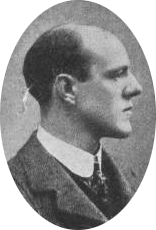Frank Reynolds (13 February 1876 – 18 April 1953) was a British artist. Son of an artist, he studied at Heatherley's School of Art.[1] His work was part of the painting event in the art competition at the 1928 Summer Olympics.[2]
Frank Reynolds | |
|---|---|
 Frank Reynolds, c. 1909 | |
| Born | 13 February 1876 Hammersmith |
| Died | 18 April 1953 Holloway Sanatorium |
| Alma mater | |
| Occupation | Illustrator, editor |
Biography edit
Frank Reynolds was born in Hammersmith, London on 13 February 1876.[3] He had a drawing called A provincial theatre company on tour published in The Graphic on 30 November 1901. In 1906, he began contributing to Punch magazine[1] and was regularly published within its pages during World War I, noted for his anti-Kaiser illustrations in Punch.[4] A collection of 199 of his illustrations is in the Punch archives.[5]
He was well known for his many illustrations in several books by Charles Dickens, including David Copperfield (c. 1911),[6] The Pickwick Papers (c. 1912) and The Old Curiosity Shop (c. 1913).[4] He succeeded F. H. Townsend as the art editor for Punch.[1]
Reynolds was one of the leading illustrators selected by Percy Bradshaw for inclusion in his The Art of the Illustrator (1917-1918) which presented a separate portfolio for each of twenty illustrators.[note 1] He was also a prolific watercolour painter and was a member of the Royal Institute of Painters in Water Colours from 1903. He continued to illustrate in black and white or in colours all his life. He became known in the 1930s and through the Second World War for characters called The Bristlewoods.[1]
One of his more notable works is entitled Jingle.
His journal contributions included
He died from pneumonia at Holloway Sanatorium in Surrey on 18 April 1953.[3][9]
Notes edit
- ^ The portfolio contained: a brief biography of Reynolds, an illustration of Reynolds at work in his studio, an explanation of Reynolds's method of working. This was accompanied by a plate showing an illustration typical of his work and five other plates showing the work at five earlier stages of its production, from the first rough to the just before the finished drawing or colour sketch.[7] Reynolds's illustration shows a disgruntled traveller accompanied by his wife and child.[8]
References edit
- ^ a b c d "Frank Reynolds (13 February 1876 - 18 April 1953, UK)". Lambiek Comiclopedia. 2 March 2019. Retrieved 25 March 2019.
- ^ "Frank Reynolds". Olympedia. Retrieved 26 July 2020.
- ^ a b Bryant, Mark. "Reynolds, Francis (Frank)". Oxford Dictionary of National Biography (online ed.). Oxford University Press. doi:10.1093/ref:odnb/66125. (Subscription or UK public library membership required.)
- ^ a b Simkin, John (August 2014). "Frank Reynolds". Spartacus Educational. Retrieved 9 March 2019.
- ^ "Frank Reynolds Cartoons". Punch. 10 October 2011. Retrieved 25 March 2019.
- ^ Dickens, Charles (1911) [1850]. The Personal History of David Copperfield (Illustrated in colour by Frank Reynolds ed.). London: Hodder and Stoughton.
- ^ "The Connisseur Bookself". The Connoisseur: An Illustrated Magazine for Collectors. 51 (204): 223. 1 August 1918. Retrieved 12 August 2020 – via The Internet Archive.
- ^ "Frank Reynolds: Frank Reynolds and His Work: The Art of the Illustrator (Limited Edition Prints)". Illustration Art Gallery with The Book Palace. Retrieved 22 August 2020.
- ^ "Mr Frank Reynolds". The Guardian. London. 20 April 1953. p. 12. Retrieved 4 April 2024 – via Newspapers.com.
External links edit
- "Punch" pictures by Frank Reynolds, 1922 London: Cassell and Co.